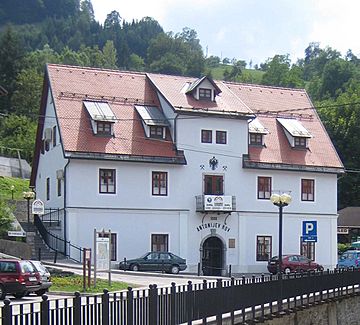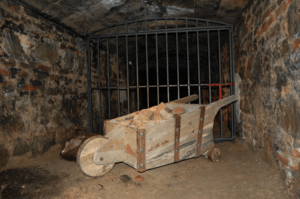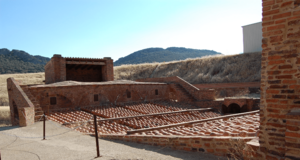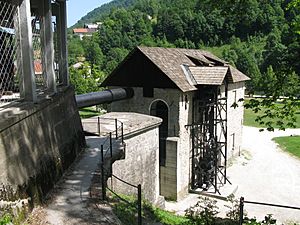Heritage of Mercury. Almadén and Idrija facts for kids
| UNESCO World Heritage Site | |
|---|---|

Antonijev rov, mine entrance in Idrija
|
|
| Location |
|
| Criteria | Cultural: (ii), (iv) |
| Inscription | 2012 (36th Session) |
| Area | 104.1 ha (257 acres) |
The Heritage of Mercury. Almadén and Idrija is a special place recognized by UNESCO as a World Heritage Site. It includes two very important mercury mining towns: Almadén in Spain and Idrija in Slovenia. These towns show how mercury was mined and traded for hundreds of years.
Mercury is a unique metal that is liquid at room temperature. It was very important in the past for getting gold and silver out of other rocks. The mines in Almadén have been used since ancient times. In Idrija, mercury was first discovered in 1490.
These two sites were the largest mercury mines in the world. They were used for a very long time, until quite recently. The mercury from these mines helped connect Europe and America through trade. It was especially important for processing gold and silver from mines in the Americas.
The sites also show how mining changed towns and societies. They include buildings, tools, and homes that tell the story of the people who worked there.
In Almadén, you can visit a Mining Park and even go underground. There are also old buildings like Retamar Castle and the San Rafael Mining Hospital. An interesting part is an old bullring shaped like a hexagon, made from 18th-century houses.
Idrija has special buildings for storing mercury and old mining equipment. You can also see where the miners lived and a theater they used.
Contents
Becoming a World Heritage Site
Idrija started the process to get its mercury heritage recognized by UNESCO in 2006. At first, they tried to join with a mercury mine in Peru. This was because of an old trade route called Camino Real.
Later, they tried to link with a silver mine in Mexico. However, this idea did not get enough support.
Finally, in 2012, Idrija and Almadén successfully joined together. Their application focused on how mercury mining influenced technology and industry. It also showed how these mines helped the economy and culture of both regions. This successful effort led to them becoming a UNESCO World Heritage Site.
Important Places at the Sites
The "Heritage of Mercury" includes many important buildings and areas. These places show the history of mercury mining.
Almadén's Key Sites
- Old town of Almadén: This is the historic center of the town.
- Buildings of the Castle's Mine: These are structures related to the main mine.
- Royal Prison of forced labor: A historic prison where forced laborers worked.
- Hospital Real de San Rafael: An old hospital for miners.
- Bullring: A unique bullring made from old houses.
Idrija's Key Sites
- Old town of Idrija: The historic center of Idrija.
- Foundry: A place where mercury was processed.
- Kamšt pump with water channel and tank: A large wooden pump that used water power to remove water from the mines.
- Water tank: A reservoir used for mining operations.
- Idrija Lagoon: Another water barrier important for the mines.
- Putrih Reservoir on the Belca River: A reservoir on a nearby river.
- Brus Reservoir on the Belca River: Another reservoir on the Belca River.
See also
 In Spanish: Patrimonio del mercurio: Almadén e Idrija para niños
In Spanish: Patrimonio del mercurio: Almadén e Idrija para niños





